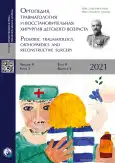A complex scalp resurfacing utilizing Integra® as temporary dressing in aplasia cutis congenita
- Authors: Yap P.1,2, Mohamad Shah N.2, Mat Saad A.Z.2,3, Wan Sulaiman W.2, Mat Johar S.N.2
-
Affiliations:
- Universiti Malaysia Sabah
- Universiti Sains Malaysia
- Management and Science University
- Issue: Vol 9, No 2 (2021)
- Pages: 229-234
- Section: Clinical cases
- Submitted: 14.02.2021
- Accepted: 04.06.2021
- Published: 09.07.2021
- URL: https://journals.eco-vector.com/turner/article/view/60815
- DOI: https://doi.org/10.17816/PTORS60815
- ID: 60815
Cite item
Abstract
BACKGROUND: Aplasia cutis congenita is a rare newborn malformation characterized by focal absence of skin. It possesses difficulty in reconstruction surgery for neurosurgeons and plastic surgeons. We report a challenging case of aplasia cutis congenita who received treatment in our center.
CLINICAL CASE: A 2-year-old boy, presented to Plastic and Reconstructive Surgery, Hospital USM, with bilateral vertex defect with encephalocele who received a series of surgical interventions since 1 month old. Unfortunately, he returned after 2 years with a chronic nonhealing scalp wound associated with dura defect and cerebral spinal fluid leakage. The wound was debrided and the swab culture result showed no organism growth. Part of the wound bed with dura defect was repaired using a small piece of transplanted fascia lata and Integra® was applied.
DISCUSSION: There is scarcity in the medical literature on the reconstructive technique of aplasia cutis congenita. In the case we described here, we successfully managed the wound with multiple application of dermal substitute (Integra®) dressing with negative pressure wound therapy and split-thickness skin graft.
CONCLUSIONS: Management of aplasia cutis congenita with skull defect remains a controversy. Its management varies depends on its pattern and underlying condition. We successfully develop a new simple method in treating scalp accutilizing Integra®.
Full Text
About the authors
Pauline Yap
Universiti Malaysia Sabah; Universiti Sains Malaysia
Email: paulineyap@live.com
ORCID iD: 0000-0002-2228-3473
MD
Malaysia, Kota Kinabalu, Sabah; Kubang Kerian, KelantanNurul Syazana Mohamad Shah
Universiti Sains Malaysia
Email: syazanashah@usm.my
ORCID iD: 0000-0001-6731-9962
PhD
Malaysia, Kubang Kerian, KelantanArman Zaharil Mat Saad
Universiti Sains Malaysia; Management and Science University
Email: armanzaharil@gmail.com
ORCID iD: 0000-0002-4003-6783
MS, Professor
Malaysia, Kubang Kerian, Kelantan; Shah Alam, SelangorWan Azman Wan Sulaiman
Universiti Sains Malaysia
Email: wsazman@yahoo.com
ORCID iD: 0000-0002-0600-9765
MS, Professor
Malaysia, Kubang Kerian, KelantanSiti Fatimah Noor Mat Johar
Universiti Sains Malaysia
Author for correspondence.
Email: fatimahmj@usm.my
ORCID iD: 0000-0003-4120-4918
MS
Malaysia, Kubang Kerian, KelantanReferences
- Brzezinski P, Pinteala T, Chiriac AE, et al. Aplasia cutis congenita of the scalp – what are the steps to be followed? Case report and review of the literature. An Bras Dermatol. 2015;90(1):100–103. doi: 10.1590/abd1806-4841.20153078
- Moros Peña M, Labay Matías M, Valle Sánchez F, et al. Aplasia cutis congenita in a newborn: etiopathogenic review and diagnostic approach. An Esp Pediatr. 2000;52(2):453–456. (In Spain)
- Smartt J, Kim E, Tobias A, et al. Aplasia cutis congenita with calvarial defects: a simplified management strategy using acellular dermal matrix. Plast Reconstr Surg. 2008;121(4):1224–1229. doi: 10.1097/01.prs.0000302588.95409.fe
- Demmel U. Clinical aspects of congenital skin defects. I Congenital skin defects on the head of the newborn. Eur J Pediatr. 1975;121(1):21–50.
- Johnson R, Offiah A, Cohen MC. Fatal superior sagittal sinus hemorrhage as a complication of aplasia cutis congenita: A case report and literature review. Forensic Sci Med Pathol. 2015;11(2):243–248. doi: 10.1007/s12024-014-9645-5
- Maillet-Declerck M, Vinchon M, Guerreschi P, et al. Aplasia cutis congenita: Review of 29 cases and proposal of a therapeutic strategy. Aplasia cutis congenita: Review of 29 cases and proposal of a therapeutic strategy. Eur J Pediatr Surg. 2013;23(2):89–93. doi: 10.1055/s-0032-1322539
- Tavasoli A, Ashrafi M, Mohammadi M, et al Aplasia Cutis Congenita (ACC) and Seizure in a Premature Neonate: Could It Be a New Neurocutaneous Syndrome? Iranian Journal of Neonatology. 2013;4(4):54–57. doi: 10.22038/IJN.2013.2014
- Bharti G, Groves L, David LR, et al. Aplasia cutis congenita: clinical management of a rare congenital anomaly. J Craniofac Surg. 2011;22(1):159–165. doi: 10.1097/SCS.0b013e3181f73937
- Kim CS, Tatum SA, Rodziewics G. Scalp aplasia cutis congenita presenting with sagittal sinus hemorrhage. Arch Otolaryngol Head Neck Surg. 2001;127(1):71–74. doi: 10.1001/archotol.127.1.71
- de Oliveira RS, Barros Juca CE, LinsNeto AL, et al. Aplasia cutis congenita of the scalp: is there a better treatment strategy? Childs Nerv Syst. 2006;(9):1072–1079. doi: 10.1007/s00381-006-0074-y
Supplementary files













